Chapter 22
...
Compare and contrast gradualism (uniformitarianism) and catastrophism explanations of the history of earth.
- Catastrophism -> The hypothesis by Georges Cuvier that each boundary between strata corresponded in time to a catastrophe that had destroyed many of the species living there.
- Gradualism -> A view of Earth's history that attributes profound change to the cumulative product of slow, but continuous processes.
- Uniformitarianism -> Charles Lyell's idea that geographic processes have no changes throughout history.\
• How does descent with modification explain the adaptations of organisms as well as the unity and diversity of life?
- -decent with modification simply means that organisms share many characteristics, each coming from a common ancestor, the diverse modifications come from each animal living in different environments. They accumulated these modifications over generations.
• How are natural selection and artificial selection different?
- Artificial Selection -> Modification of a species by human intervention so that certain desirable traits are represented in successive generations.
- Natural Selection -> The process in nature by which, according to Darwin's theory of evolution, only the organisms best adapted to their environment tend to survive and submit their genetic characteristics in increasing numbers to succeeding generations.
• What are Darwin's four observations/inferences about nature?
- Observation 1 - members of a population vary in inherited traits.
- Observation 2- all species can produce more offspring than their environment can support, and many survive to reproduce.
- Inference 1 - individuals whose inherited traits give them a higher probability of surviving and reproducing in a given environment tend to leave more offspring.
- Inference 2 - the unequal ability of individuals to survive and reproduce will lead to the accumulation of favorable traits in the population over generations.
• Summarize the main ideas of natural selection. What role do individuals versus populations have in this process?
- Natural selection is a process in which individuals with favorable inherited traits are more likely to survive and reproduce
• List two direct observations of evolutionary change and explain.
- Two examples provide evidence for natural selection: natural selection in response to introduced plant species, and the evolution of drug-resistant bacteria
• What are homologous structures?
- Homologous structures are anatomical resemblances that represent variations on a structural theme present in a common ancestor
• Explain the four types of data that are used to document evolutionary change.
- Homology
- The fossil record
- Biogeography
- Direct observations
Chapter 23
...
• List and explain four sources of genetic variation.
- Mutation
- Translocation
- gene duplication
- Crossing over
• Why is genetic variation important?
- Variation in heritable traits is a prerequisite for evolution
• List the five conditions for Hardy-Weinberg equilibrium and explain why populations are rarely in Hardy-Weinberg equilibrium.
- No mutations
- Random mating
- No natural selection
- Extremely large population size
- No gene flow
• What does the Hardy-Weinberg equation test?
- Tests whether a population is evolving or not.
- The Hardy-Weinberg equation describes the genetic makeup we expect for a population that is NOT evolving at a particular locus
• Describe three ways that allele frequencies can be altered in a population.
- Natural selection
- Natural selection results in alleles being passed to the next generation in proportions that differ from those in the present generation.
- Genetic drift (bottleneck and founder effects) including the
four key points
- The process in which chance events cause allelic frequencies to fluctuate unpredictably from one generation to the next
- The bottleneck effect is a sudden reduction in population size due to a change in the environment
- The founder effect occurs when a few individuals become isolated from a larger population
- Explain gene flow
- The transfer of alleles into or out of a population due to the movement of fertile individuals or their gametes
• How does natural selection lead to adaptive evolution?
- Natural selection consistently selects for traits that will allow members of a population to best adapt to their environment, while gene flow and genetic drift can possibly decrease the advantageous alleles
• Explain the role of directional, disruptive, stabilizing, and sexual selection in natural selection.
- Directional selection favors individuals at one extreme end of the phenotypic range
- Disruptive selection favors individuals at both extremes of the phenotypic range
- Stabilizing selection favors intermediate variants and acts against extreme phenotypes
- Sexual selection is natural selection
for mating
- It can result in sexual dimorphism, marked differences between the sexes in secondary sexual characteristics
- Intrasexual selection is direct competition among individuals of one sex (often males) for mates of the opposite sex
- Intersexual selection, often called mate choice, occurs when individuals of one sex (usually females) are choosy in selecting their mates
Chapter 24
...
• What are the four different species concept approaches to defining a species?
- The biological species concept states that a species is a group of populations whose members have the potential to interbreed in nature and produce viable, fertile offspring; they do not breed successfully with members of other populations
- The morphological species concept defines a species by structural features
-
The ecological species concept views a species in
terms of its ecological niche
- Whether two can survive in each other’s environment.
- The phylogenetic species concept defines a species as the smallest group of individuals on a phylogenetic tree
• Know the prezygotic and postzygotic reproductive barriers that contribute to reproductive isolation.
- Prezygotic barriers block fertilization from occurring by
- Impeding different species from attempting to mate
- Preventing the successful completion of mating
-
Hindering fertilization if mating is successful
- Habitat isolation: Two species encounter each other rarely, or not at all, because they occupy different habitats, even though not isolated by physical barriers
- Temporal isolation: Species that breed at different times of the day, different seasons, or different years cannot mix their gametes
- Behavioral isolation: Courtship rituals and other behaviors unique to a species are effective barriers to mating
- Mechanical isolation: Morphological differences can prevent successful completion of mating
- Gametic Isolation: Sperm of one species may not be able to fertilize eggs of another species
- Postzygotic barriers prevent the hybrid zygote from
developing into a viable, fertile adult
- Reduced
hybrid viability
- Reduced hybrid viability: Genes of the different parent species may interact and impair the hybrid ’s development or survival in its environment
- Reduced hybrid fertility
- Reduced hybrid fertility: Even if hybrids are vigorous, they may be sterile
- Hybrid breakdown
- Hybrid breakdown: Some first-generation hybrids are fertile, but when they mate with each other or with either parent species, offspring of the next generation are feeble or sterile
- Reduced
hybrid viability
• Explain how allopatric and sympatric speciation occur.
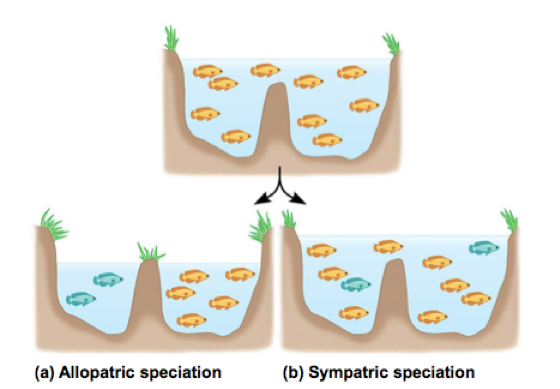
- In allopatric speciation, gene flow is
interrupted or reduced when a population is divided into
geographically isolated subpopulations
- For example, the flightless cormorant of the Galápagos likely originated from a flying species on the mainland
- sympatric speciation occurs in populations that live in the same geographic area. Occurs if gene flow is reduced through polyploidy, sexual selection, and habitat differentiation
• Explain the time course of speciation in terms of the fossil record and rate of speciation.
Fossil records don’t show gradual changes between species they just show a rapid change
Chapter 25
...
• Differentiate between macroevolution and microevolution.
- Macroevolutionary changes over large time scales
- Formation of a new species
- microevolution -changes within a species; not the creation of a
new species
- Examples: resistant bacteria to antibiotics and insects resistant to pesticides.
• Understand what information can be found in the fossil record.
- Old layers in the fossil record would be associated with older species
- The fossil record reveals changes in the history of life on Earth
- The fossil record shows changes in kinds of organisms on Earth over time
- The fossil record is biased in
favor of species that
- Existed for a long time
- Were abundant and widespread
- Had hard parts
- Fossil record only shows sudden change not gradual change in species.
- The fossil record is biased in favor
of species that
- Existed for a long time
- Were abundant and widespread
- Had hard parts
• Explain how radiometric dating is performed.
- The "absolute" ages of fossils can be determined by
radiometric dating
- radioactive “parent” isotope decays to a “daughter” isotope at a constant rate
• Know the hypothesis for the origin of eukaryotes through serial endosymbiosis.
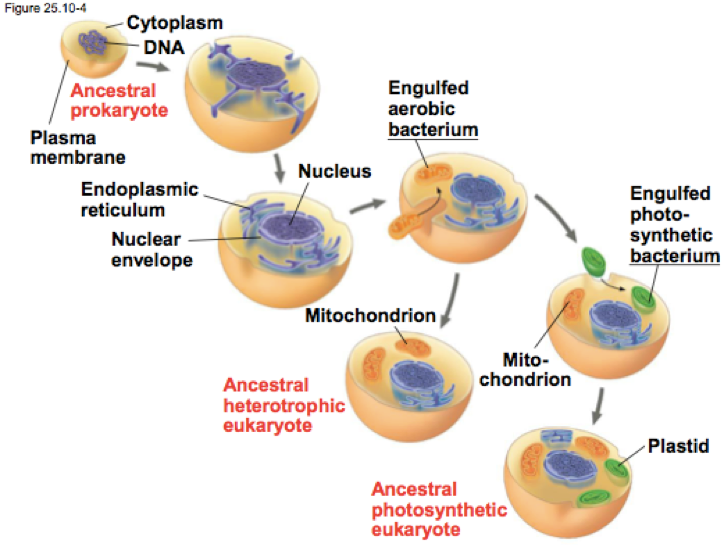
- The endosymbiont theory proposes that mitochondria and plastids (chloroplasts and related organelles) were formerly small prokaryotes living within larger host cells
• Understand how continental drift could explain the distribution and diversity of life on earth.
- Continental drift has many effects on living organisms
- A continent’s climate can change as it moves north or south
- Separation of land masses can lead to allopatric speciation
• What is the role of Hox genes in animal development?
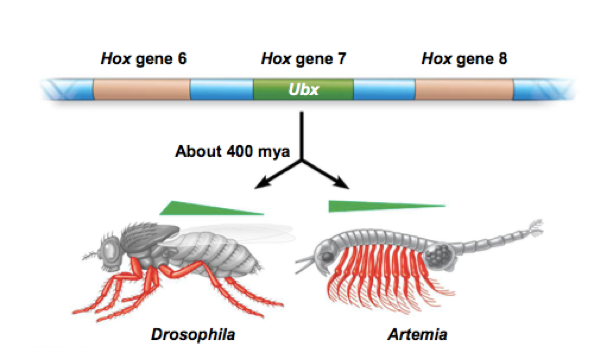
- homeotic genes that determine where basic features are located, providing positional information in an animal embryo. Changes to these genes result in significant morphological changes. For example two hox genes prevent limb formation in snakes.
Chapter 26
...
• How can hierarchical classification and phylogeny be linked together?
- Phylogeny is the evolutionary history of a species or group of related species
- Systematists depict evolutionary relationships in branching phylogenetic trees
• Know how to "read" a phylogenetic tree.
- Phylogenetic trees show patterns of descent, not phenotypic similarity.
- Phylogenetic trees do not indicate when species evolved or how much change occurred in a lineage.
- It should not be assumed that a taxon evolved from the taxon next to it.
- Shared ancestral
- Shared derived characteristics
• Explain how phylogenies are determined.
- morphological and molecular data. To infer phylogenies, systematists gather
- information about morphologies, genes, and
- biochemistry of living organisms.
• Understand the difference between analogy (convergent evolution) and homology (shared ancestry).
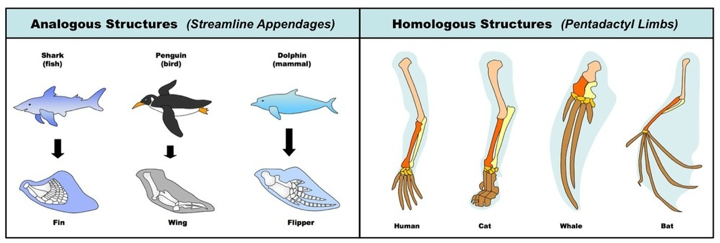
- Homology is similarity as a result of shared ancestry
- Analogy is similarity due to convergent evolution.
- TAXON
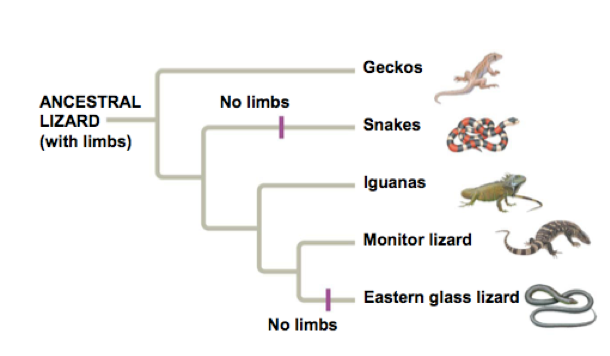
- A unit of heiarchy
• What is a shared derived character?
- A shared derived character is an evolutionary novelty unique to a particular clade. In comparison with its ancestor, an organism has both shared and different characteristics.
• How are maximum parsimony and maximum likelihood different?
- Maximum parsimony assumes that the tree that requires the fewest evolutionary events (appearances of shared derived characters) is the most likely
- The principle of maximum likelihood states that, given certain rules about how DNA changes over time, a tree can be found that reflects the most likely sequence of evolutionary events
- Parsimony is the fewest turns But since there’s construction the route is slower -so maximum likelihood
• What are molecular clocks and how can they be used?
- A molecular clock uses constant rates of evolution in some genes to estimate the absolute time of evolutionary change
- similar genes or segments of DNA occur in different species and appear to have a reliable mutation rates, they can be used as a molecular clock